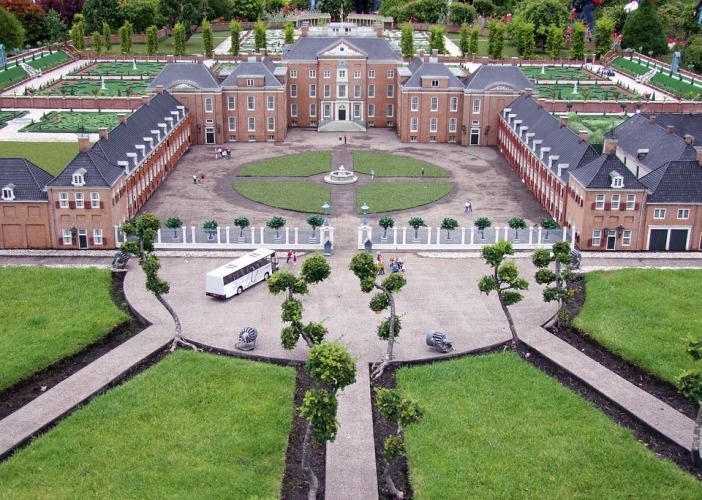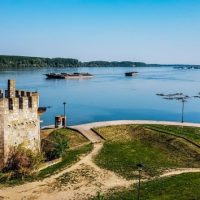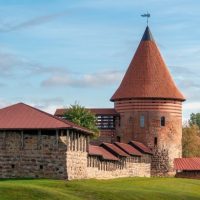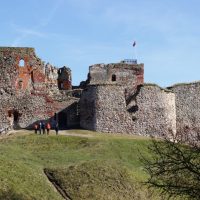The Netherlands is just a tad bigger than the state of Maryland.
However, within the confines of what makes up the European nation, there are around 300 castles.
From the early Middle Ages through the last century, these fortresses have been popping up all over the land.
That’s even more impressive when you realize how much of the country would be underwater without the dike system.
To get a better idea of what these sometimes-ancient buildings look like, we put together a list of the best castles in all of Holland.
10 Most Beautiful Castles in Holland
1. Paleis Het Loo
Paleis Het Loo, Dutch for The Lea, was built in 1684 by the House of Orange-Nassau.
The location was in the middle of Hodge Veluwe, a thick forest outside of Apeldoorn.
For the next three centuries, family members from the distinguished house that built the castle continued to call it home.
The first of Het Loo’s inhabitants was Stadtholder William III, the future king of England.
He built it as a fortified hunting lodge.
No matter what angle you’re at, this castle is breathtaking.
From the air, you can see how meticulously kept the gardens are and how the estate spreads across the land.
Pulling up to the front entrance is a grand affair.
The U-shaped exterior will swallow you whole with amazement at how large, both vertically and horizontally, the building is.
Stepping inside, opulence might be the only word to describe the majestic murals and lush carpeting.
Visitors can tour the halls with an audio guide.
2. Duivenvoorde Castle
It’s not every day that a building from 1226 is structurally sound enough to be toured in modern times.
However, that is the story of Duivenvoorde Castle.
Actually, we don’t know exactly how much older the castle is, but it was mentioned first that year.
Even more of a mystery is how the same family has owned the castle after all these years.
All these centuries, more like it.
The way it’s surrounded by a lake and trees makes it the perfect place to visit in the spring or summer.
Duivenvoorde Castle is one building with three large parts.
Each section has a pointy roof with a slender tower atop it.
The massive rich red rugs and cascading windows make the already large home feel even more spacious.
Even though a family lives here, the castle is open for visitors Thursday through Sunday in the afternoon.
3. Doorwerth Castle
Situated right up against the Rhine River of Arnhem is Doorwerth Castle.
Similar to Duivenvoorde, we don’t know exactly when it was first moved, but it was mentioned as early as 1260.
The reason it was written about was to say that it had been seriously damaged by fire.
20 years later, it was fired upon once more.
The difference, though, was that the rebuild was in stone.
That second fire merely served as an inconvenience, overall.
More than a century later, the owner of the day loved it so much that he decided to expand upon it.
There were a couple more major expansions during the Middle Ages.
The love faded and by the end of the 1700s, it was uninhabitable.
Never fear, however, because Baron JAP Van Brakell bought and restored it.
Things were good for a time until disrepair reared its ugly head again.
Twice.
As of the early 80s, a foundation brought Doorwerth back to its former glory under the baron.
The castle is now a museum.
4. Heeswijk Castle
You get to step foot in two different worlds when visiting Heeswijk Castle.
The first is a peek into the architecture of the 11th century.
Next is the life and times of Holland during the 1800s, thanks to the museum.
This is the type of castle you imagine when you hear the word.
Heeswijk has towers, is surrounded by water, and is stone.
There’s also a forest around it.
What could be more photogenic than crossing a bridge over the moat with two towers on either side?
Inside, there’s a floor-to-ceiling library, marble floors in a checkered pattern, giant artworks, a themed dining room, and extra wide doorways.
Surely it would have been an inspiration for a Jane Austen novel.
5. Ammersoyen Castle
Built in 1300 or 1350, Ammersoyen Castle is one of the best-kept medieval castles in the country.
The Van Herlaer family wanted a defensive structure next to Maas River.
Not long after the completion, the river was moved.
That didn’t stop the castle from being surrounded by a moat that is still providing a barrier between the castle and the land to this day.
The stone structure has multiple rounded corner towers that make you wonder how many stories are trapped inside.
There are parts of the interior that aren’t as modern as you’d imagine.
Instantly, visitors are transported back to another time with the unique, inset windows and massive fireplaces.
Ammersoyen Castle is open for tours and events throughout the year.
6. Breda Castle
Regarded as an early example of monumental Renaissance architecture, Breda Castle was built in the 14th century.
The city sort of built up around it, hence the name.
If you’re wondering how a castle built in the 1300s would qualify as Renaissance, it’s just a matter of time.
Over 200 years later, a descendant of the Baron of Breda, who purchased the estate in 1353, remodeled the castle in the Renaissance style.
Two years later, he died, and his son added a chapel.
Over the next three centuries, ownership changed several times with more additions.
Even King William II got in on the action.
Standing on the elongated walkway up to the castle, you might not realize there’s water all the way around.
The building is so stately that visitors are more likely to be drawn to how wide it is versus the long bridge leading up to the front door.
7. De Haar Castle
Only about half an hour outside of the capital is a big castle you wonder if it can be seen from space.
At basically any angle, De Haar is reminiscent of a fairy tale castle.
Of course, this was far from the vision when it was built just before the turn of the 15th century.
To be fair, we don’t really know what that vision might have been since some of the original walls were burned down.
Rebuilt by the mid-1500s, it fell into ruins 100 years later.
De Haar would more or less be passed around until the late 1800s when the restoration was finally achieved.
The style is Gothic Revival, and it would be easy to get lost in its beauty as well as its halls.
There is a multitude of towers in the castle overlooking the immaculate gardens outside.
A walk-through is a walk into the past.
8. Hoensbroek Castle
A runner-up in size only to De Haar, Hoensbroek Castle is known as the most lordly stronghold between the Rhine and the Meuse.
Constructed in sections, the first stone was placed in 1250 and other areas are dated from 1360.
It was home to the Hoen van den Broeck family for 600 years.
After a long time with no one living there, the castle was bought and renovated in the 1930s.
Towers on Hoensbroek are square, as opposed to round, like other castles.
But what it has in common with similar castles is being surrounded by water and plentiful gardens.
The fortress offers tours and special events during the year.
9. Muiden Castle
Muiden Castle, also known as Muiderslot, is only about 15 minutes outside Amsterdam and is well worth the drive.
At the opening of Vecht River, it is the go-to castle for a number of movies and shows that take place during the Middle Ages.
Looking at the foreboding entrance and tall towers, it’s easy to see why.
The picturesque landscape would be full of visual opportunities to recreate scenes, such as battle, daily life, and royal drama.
Muiden has been around since the end of the 13th century, surely drama is part of the walls.
Of course, the original building was destroyed and rebuilt a century later, but who’s counting?
10. Doornenburg Castle
Had Doornenburg been built as a castle, to begin with, it would take the title of oldest.
However, it started as Villa Dorenburc in the 800s.
400 years would pass before it was turned into a legitimate castle.
The fortress was left in ruins during the 1800s.
A foundation was created to bring it back to life in 1941.
Unfortunately, two years later, a British bomb destroyed much of that effort.
After a 20-year rebuild, Doorenburg was completed in 1968.
Netherlands Safety Overview
READ THE FULL REPORT: Netherlands Safety Review
Safety Index:
- OVERALL RISK: LOW
- TRANSPORT & TAXIS RISK: LOW
- PICKPOCKETS RISK: MEDIUM
- NATURAL DISASTERS RISK: LOW
- MUGGING RISK: LOW
- TERRORISM RISK: MEDIUM
- SCAMS RISK: LOW
- WOMEN TRAVELERS RISK: LOW
Frequently Asked Questions
What's the biggest castle in Amsterdam?
De Haar Castle, which is on 135 acres and has 200 rooms.
Not only is it easy to see if you’re visiting Amsterdam, but it will also probably be precisely what you envision when you think about castles.
There is a suspension bridge, moat, and towers, and it’s made of stone.
What's the most popular Dutch castle?
It might not be super surprising to learn that the biggest castle is also the one that gets the most tourists.
Millions of people stop by De Haar Castle each year.
To be fair, it runs a tight competition with Muiden Castle.
Why did The Netherlands have castles, to begin with?
During the Middle Ages, castles were built to defend an area.
If necessary, the locals would be safe inside the stone building walls, especially ones fortified for battle.
These were tough times for everyone, especially those across Europe where land seemed to change hands too often.
Luckily, the need to hide behind defense structures lessened and these castles were turned into homes.
Does the Dutch royal family live in a castle?
Currently, the family lives in Huis ten Bosch Palace.
It’s not exactly a castle, but it could fortify the family, for sure.
While the immediate family of King Willem Alexander lives in a palace as opposed to a castle, other family members do.
Princess Beatrix has taken up residence in Drakensteyn Castle since 2014.











